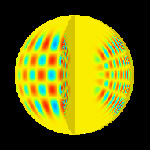

 The asteroseismology program
The asteroseismology program
By means of a technique known as Asteroseismology, astronomers believe that the pioneer space mission CoRoT will, for the first time, unveil the interior of stars other than our sun, and provide key information about the way they evolve, from the moment they are born to the end of their lives.
Stars can produce waves that resonate in their interiors. As a consequence, certain surface properties of stars - like brightness and velocity - can vary periodically in time. Just as in a musical instrument, the natural notes - or modes of oscillation - of a given star depend on the size and properties of the cavity in which the waves propagate. In a star this cavity is the interior of the star itself, or a fraction of it. Hence, through Asteroseismology - i.e. by studying the oscillations of stars - astronomers can probe stellar interiors. Since the interiors of stars are hidden from direct observation, stellar oscillations provide a unique tool to 'look' inside stars.


The study of oscillations in the Sun - i.e. Helioseismology - has proven extremely successful. Unfortunately the detection of tiny brightness variations is much harder in distant stars. For solar-like stars, the scintillation noise produced by the Earth?s atmosphere makes it impossible to detect the brightness variations from the ground. Even though larger brightness variations may be detected from the ground in more massive stars, the number of modes of oscillation detected in this way for such stars is in general insufficient to extract the desired information about their interiors.
Positioned above the Earth's atmosphere, CoRoT will not only be able to detect brightness variations as small as those expected in solar-like stars, but will provide long, continuous observations of the same star. Long, uninterrupted observations of a star are necessary to characterize the modes in which the star oscillates - i.e. their periods (varying between 1 minute and 3 hours for CoRoT targets), amplitudes (as small as few parts per million), and life times (as short as a few days) - which, in turn, are needed for Asteroseismology. Even with networks of telescopes working under the best conditions, it would hardly be possible to acquire such long uninterrupted observations from the ground.
Two sub-programs will be carried out within the asteroseismic component of the space mission: the central program and the exploratory program. The central program will consist of observing the same field of view - and thus the same stars - for periods of 150 consecutive days. At least 5 such runs are expected, during which one main bright target and several fainter ones will be observed. These long runs will allow for the detailed study of about 50 stars which are chosen for their diagnostic potential. The exploratory program will consist on a number of smaller observation runs, lasting 20 consecutive days, during which several tens of stars with different masses, ages and chemical compositions will be observed, to cover the broader picture of stellar evolution.
Stars are one of the primary constituents of the Universe, and the only one providing the environment needed to produce most chemical elements that are known to exist. Understanding stars is also an essential step to understand phenomena that are directly related to them, such as the formation of planetary systems and the development of conditions such as those existing on Earth. By 'looking' inside stars, astronomers believe that CoRoT will teach us not only about the stars themselves, but also about the Universe as a whole.
